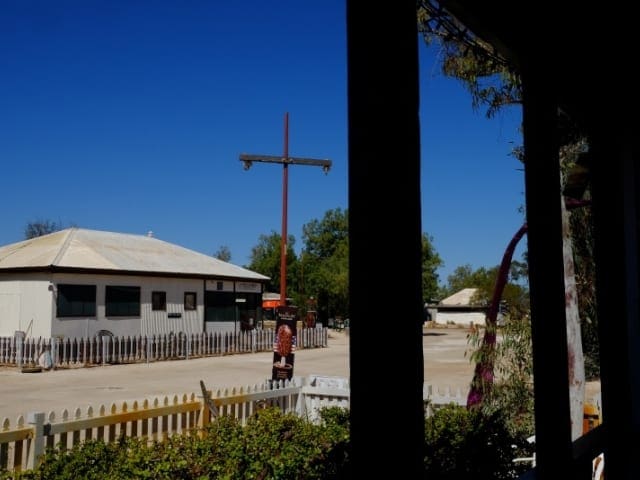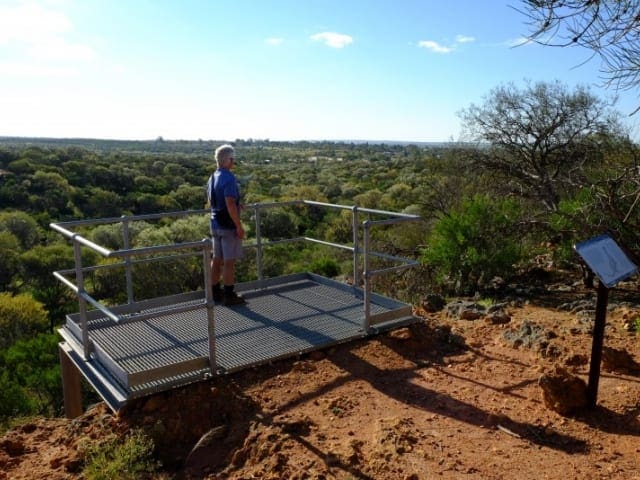Hike at a Glance
Max elevation: 43m
Min elevation: 10m
Total Ascent: 51m
Hike overview
The Red Bluff Beach Trail (Beach to Bluff Trail) in Kalbarri National Park offers a unique opportunity to combine a moderate hike with a glimpse into the lives of the Nanda people, the traditional custodians of this land.
This 1.6-kilometer return trail, also known as the Gaba Gaba Yina trail in the Nanda language, takes you on a historical journey. The path starts at Red Bluff Beach and gradually ascends to a spectacular lookout point perched high above the coastline.
The effort of the climb is quickly forgotten as you're rewarded with breathtaking panoramic views. From the lookout, you can admire the vast expanse of Red Bluff Beach, Jakes Point, the mouth of the Murchison River, and Meanarra Hill.
Classified as grade 2, the Red Bluff Beach Trail offers a moderate challenge. The path is steeper than some other Kalbarri walks, so be prepared for some incline as you make your way to the lookout. The return journey typically takes approximately 45 minutes to complete.
If you're fortunate enough to visit during wildflower season (July to October), the vibrant blooms blanketing the landscape add another layer of beauty to your hike.
Gallery
Got some great shots from this hike? Upload your photos here to inspire others and show off the beauty of the trail!
Click to view form >>
Submitting your photos doesn’t mean you lose ownership. You can be credited for your contributions, and you can request removal at any time.
Content use
Please don’t copy GPX files or content from this site to AllTrails or other platforms. Each trail has been personally mapped, documented, and refined to support Australia’s bushwalking and hiking community. While some details come from land managers, every listing reflects significant personal effort. This is a free, community-driven initiative—your respect helps keep it that way.
Walk map and GPX file
Max elevation: 43 m
Min elevation: 10 m
Total climbing: 51 m
Total descent: -51 m
Getting there
Getting to the trailhead: Kalbarri National Park.
The starting point for the Beach to Bluff Trail is conveniently located at Red Bluff Beach, just 5 kilometers south of the Kalbarri townsite. This location is approximately 570 kilometers north of Perth.
Closest towns to this walk: Ajana, Dongara, Geraldton, Horrocks, Kalbarri, Mullewa, Murchison, Nabawa, Northampton, Shark Bay
About the region
Kalbarri National Park pays respect to the Nanda people as the traditional custodians of this land. The park itself encompasses the lower Murchison River, where the river has carved a magnificent 80km gorge through red and white banded sandstone. A breathtaking perspective of this natural wonder can be obtained from the Kalbarri Skywalk, a dual-platform structure jutting out over the gorge. Numerous walking trails descend into the gorge, allowing visitors to experience its colorful splendor firsthand.
The park also boasts an impressive coastline sculpted by wind and wave erosion. Here, towering cliffs plunge 100 meters towards the ocean, offering equally stunning views. Particularly during spring, the wildflowers blanketing the landscape add another layer of vibrant beauty.
The town of Kalbarri, situated at the mouth of the Murchison River, serves as a vibrant hub for both fishing and tourism. This town provides a convenient base for exploring the park's many offerings. Activities range from sightseeing and picnicking to more adventurous pursuits like abseiling, rafting, and canoeing. Don't forget to book tours in advance for these activities to ensure a spot.
With so much to see and do, allow ample time to fully experience Kalbarri National Park. For panoramic views of Murchison Gorge, be sure to venture out onto the Kalbarri Skywalk. It's important to note that summer temperatures can be extreme. To ensure a safe and enjoyable visit, plan hikes during the cooler months (May to October). When heading out on hikes, prioritise safety: start early in the morning, carry sufficient water (1 liter per hour per person), wear sun protection, comfortable clothing, and sturdy footwear. As there's no potable water available within the park, remember to bring your own supply.
Similar walks nearby
Looking for more walks in or near Kalbarri National Park? Try these trails with a similar difficulty grade.
Track grade
Grade 2 (Easy) - A Gentle Introduction to Inclines: Grade 2 on the AWTGS represents easy walking tracks that offer a slightly more challenging experience compared to Grade 1. Similar to Grade 1, no prior bushwalking experience is required. The track surface is typically hardened or compacted and may have gentle hill sections or occasional steps. The total distance of a Grade 2 walk is typically no greater than 10 kilometers. These walks are still suitable for families with a bit more experience or those seeking a gentle introduction to some inclines.
Explore safe
Plan ahead and hike safely! Carry enough water, pack layers for changing conditions, and bring safety gear like a torch, PLB, and reliable communication device. Check official sources for trail updates, closures, and access requirements, and review local weather and bushfire advice. Most importantly, share your plans with someone before you go. Being prepared makes for a safer and more enjoyable hike! Stay Safe, Explore More, and Always #ExploreSafe.
Packing checklists
What you carry in your pack depends on factors like weather, terrain, and your adventure type. Not sure what to bring? My free planning, food, and packing checklists are a great starting point, covering day hikes, overnight trips, and multi-day adventures. Use them to customise your kit and always prioritise safety.
Let someone know
Before heading out, take a moment to fill out your trip intentions form. It’s a quick way to share your hike details with family or friends. If something goes wrong, they can notify emergency services, ensuring a faster response and peace of mind. Stay safe and enjoy your adventure
Suggest an edit
Spotted a change on this trail? Maybe there are new features, the route has shifted, or the trail is permanently closed. Whatever the update, I’d love your input. Your feedback helps fellow hikers stay informed and ensures that our trail info stays fresh and reliable.
Acknowledgement of Country
Trail Hiking Australia acknowledges the Traditional Owners of the lands on which we hike and pay respects to their Elders, past and present, and we acknowledge the First Nations people of other communities who may be here today.






